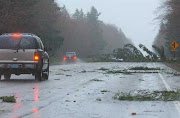By CATE GABLE
Thursday, January 03, 2008
Reprinted from The Chinook Observer
When the storm hit, Suzanne Staples, RN, a Klipsan homeowner since 1995, found herself worried about the birds. Staples, a lifetime member of the Portland Audubon Society as well as the Peninsula's Shoalwater Birders, knows that storms mean hard times for our wildlife.
"When a storm is in full-swing, birds and other species are unable to feed. So a four- or five-day storm is a real hardship that many birds and other wildlife can't survive."
On Monday of the Big Blow, the flock of ducks generally meandering in the wetlands just in front of her house had disappeared. But Staples noticed a tiny Anna's hummingbird clinging to the branches of her maple tree.
"Anna's hummingbirds winter over on our Peninsula," said Staples. "This little hummer would hang onto our tree and then, between gusts, would bomb down to our feeder for a quick sip of sugar water. Its timing was perfect."
But Staples couldn't help but wonder 'how were the gulls faring? The murres? The cormorants? The eagles?'
Staples is a board member and regular volunteer for the Wildlife Rehab Center of the North Coast, a non-profit facility just outside of Astoria that administers to injured, sick, or orphaned native wildlife and, if possible, releases creatures back into the appropriate natural habitat.
When I asked Staples about her storm story, she suggested I come down with her to visit the rehab center and see for myself some of the "post-storm victims."
So early on the day after Christmas, we rode to Olney, Ore., site of the 105-acre grounds of the Wildlife Rehab Center, run by the seemingly indefatigable director, Sharnelle Fee.
Just inside the door of the hospital, a bald eagle screeched at our intrusion. Before I could sufficiently take in this wonder, Staples and I were hounded by a brown pelican, standing nearly three-feet tall and audaciously hungry. He snapped his huge bill at our legs and butts like an overgrown and dangerous chicken, while Staples, with enviable sang-froid grabbed his upper bill and scolded him.
I could see then that both his wing joints were scraped raw. We tossed whole fish into a plastic tub on the floor and immediately he forgot about us.
The center had a full house: Peregrine falcon, two red-tailed hawks, barn and saw whet owls, gulls, murres, cormorants, fulmars, a domesticated white dove, even a porcupine all occupied the stainless steel cages at the hospital.
The eagle would soon have its broken leg X-rayed (two pins had been put in place by a local vet). In another room, fridges held frozen fish of all varieties, across from shelves of medical supplies. The washers and dryers in the laundry room were running non-stop.
I asked Fee about the effects of our hurricane on seabirds and other wildlife.
"The birds can't get their lives together when there are consecutive storms," she said, "And they don't get a lot of second chances. Animals get behind in their feedings, they get weak and they can't catch up."
"We were bracing for this blow but we didn't see the effects until about five days after the storm. Then we started getting calls. We think the winds blowing south to north were so strong they blew our wildlife right up the coast."
The Wildlife Center is a volunteer-only organization with funds provided solely by donations. Just the food bill is $40,000 annually - and that's a lot of frozen fish. Calls to pick up injured or sick birds and other animals come in daily from both the Washington and Oregon coasts.
When I ask about a specific bird story, Fee shares, "We got a call about an eagle under a picnic table. Eagles mate for life and we found out that the male eagle had been bringing food to his injured mate at this park for several days."
Then she points, "... and that is our Christmas loon."
Sharnelle Fee has dedicated her life to caring for injured wildlife. It's good to know that in a disaster all compass points are covered - that while some of us are tending to the needs of our human elders when the power goes off, others are providing succor to our wildlife neighbors.
Right now the center needs more volunteers from our Peninsula, especially during these stormy winters, both to transport birds to pick-up locations and for physical help at the center.
It's not glamorous work - there is a lot of bird poop to clean up - but the rewards are palpable. As Staples puts it, "I have been a birder all my life and, especially in a time of crisis, this feels like giving back all the pleasure that birds have given me."
Staples will be one of the many community members attending our post-storm Community Forum on Jan. 26 at the Ocean Park Elementary School to share her story and to invite further discussion.
If you would like to help with this event, please e-mail Nanci Main at (nanci@willapabay.org) or call her at 665-5340, and keep your eyes on the Chinook Observer for more information in the coming weeks.
For more information about the Wildlife Center see: (www.coastwildlife.org/) or phone: 503-338-0331. Donations can be sent to Wildlife Center of the North Coast, P.O. Box 1232, Astoria, OR 97103.
1.22.2008
Subscribe to:
Post Comments (Atom)



No comments:
Post a Comment